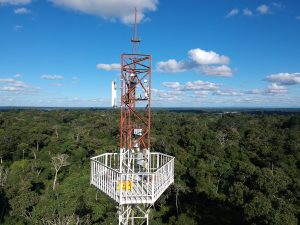Studying Greenhouse Gas Fluxes to Learn How Climate Change Affects the Amazon Rainforest
June 15, 2021
These past few weeks significant scientific advances have been made at our Los Amigos Biological Station by the Pontificia Universidad Católica del Perú (PUCP).
The research group, led by professors Dr. Eric Cosio and Dr. Norma Salinas from the Department of Science and the Institute for Nature, Earth and Energy at INTE-PUCP, has installed an atmospheric flux system in our Los Amigos observation tower at a height of 196-foot (60 meter) above the ground to measure carbon, methane, and water vapor in the air. They are studying greenhouse gas fluxes to understand whether forests act as sinks or sources of these gases, and also show how they differ in different ecosystems (primary forest, secondary forest, wetlands and Andean highlands). They have multiple towers with these systems in various districts of Peru for comparison purposes.
Biometric data – that is, statistical analysis of ecological information – was taken from a forest area close to the tower to classify the forest next to the flux devices, and to estimate how much carbon is currently present in the standing forest.
 This research and our collaboration with PUCP is a key example of how we put science and technology to work for conservation, helping to discover how climate change is affecting the Amazon Rainforest. The PUCP team will return to Los Amigos in August to recalibrate equipment, and then every three months afterwards to obtain data. They are looking to enhance the system with more gas flux devices over time, such as adding an atmospheric mercury meter. The gas flux data will be uploaded to a global platform for flux data, connecting our Los Amigos Biological Station to the rest of the world. Additionally, a weather station was placed on top of the Los Amigos tower, which provides very precise, digital, meteorological data.
This research and our collaboration with PUCP is a key example of how we put science and technology to work for conservation, helping to discover how climate change is affecting the Amazon Rainforest. The PUCP team will return to Los Amigos in August to recalibrate equipment, and then every three months afterwards to obtain data. They are looking to enhance the system with more gas flux devices over time, such as adding an atmospheric mercury meter. The gas flux data will be uploaded to a global platform for flux data, connecting our Los Amigos Biological Station to the rest of the world. Additionally, a weather station was placed on top of the Los Amigos tower, which provides very precise, digital, meteorological data.
Special thanks to the Andes Amazon Fund and the Gordon and Betty Moore Foundation, for the support that made possible the purchase and installation of 8 solar panels that are powering the flux devices.
Want to help make science possible?


